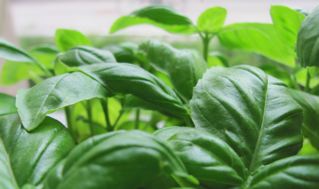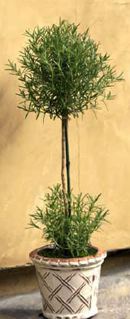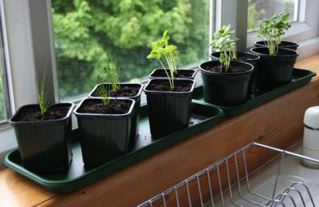
What better day than today to add some fresh herbs snipped from a windowsill or kitchen garden to your plate?!
It just so happens that March 14th is the 5th observance of Registered Dietitian Day (the second Wednesday of March).
How appropriate to be celebrating food, nutrition and dietetics on this March 14, which also happens to be “National Pi Day” as in “pi” or 3.14 relative to a circle or round plate. After all, this year’s National Nutrition Month (NNM) theme focuses on “Get Your Plate in Shape!”
NNM “Widget” (aka image code) courtesy of the Academy of Nutrition and Dietetics.

Farmer’s Markets open on weekdays (as opposed to only weekends) are drawing in crowds already in warmer sectors of the country well before May, selling lots of fresh herb bunches or herb plants. After all, flowers are already blooming in the Southern US.
Basil plant image courtesy of rgbstock.com
It’s still too early to plant outdoors in the NorthEast as frosts and snow could always show up another week, but it’s a great time to think about windowsill and other kitchen gardens if someone doesn’t already have herbs growing inside their home.
In much of the NorthEastern United States, the weather can be more fickle at this time of year, but curiously some parts of it are seeing an unusual warm streak with lots more outdoor activity with sunshine right about now.
By May, it will be time in colder agricultural zones to seed and plant outdoors, and even sooner if someone has either greenhouse set ups or brings planting containers outdoors on good days and brings them back in again at night and keeps them in on colder days.
Spring, aka the Vernal Equinox, officially begins on March 20, 2012 in much of the United States.
 In honor of Spring, many a Home and Garden show will pop up in March across the NorthEast and elsewhere featuring all sorts of forced bulbs and garden plantings grown indoors during winter months to specifically be ready to bring to such a show.
In honor of Spring, many a Home and Garden show will pop up in March across the NorthEast and elsewhere featuring all sorts of forced bulbs and garden plantings grown indoors during winter months to specifically be ready to bring to such a show.
Those displays clearly demonstrate that you can bring Spring to your kitchen much sooner by taking advantage of Windowsill and other kitchen gardens right now, if you haven’t been doing so otherwise this winter.
Rosemary Topiary image courtesy of Colorado Extension Service.
This week, many major cities will have such Home and Garden Shows and this area in which we happen to live is no exception. Tuesday the vendors started moving in to the event location and by Thursday evening the show will open! As it happens, there are State Fair grounds in this area that vendors can use, so it provides lots of potential indoor space in the Center of Progress building for them to showcase their offerings.
Check to see if there might be a local Home and Garden Show event in your area if you are looking for some eye candy inspiration!
Even if you don’t go to a “Home and Garden Show” per se, herb plants are showing up for sale everywhere already growing in various size containers, in case you didn’t happen to start any seeds yourself this winter.
 If you haven’t grown any herbs indoors from seed or young seedlings yourself before, this might be the perfect year to start!
If you haven’t grown any herbs indoors from seed or young seedlings yourself before, this might be the perfect year to start!
Although there are all sorts of fancy lighting setups and more for growing herbs indoors, you can also just use whatever natural light there is.
In warmer parts of the country, one can sow seeds outdoors based on USDA agricultural zone frost predictions for your area at some point in Spring, or hopefully seeds from previous year’s plantings may reward you with new crops popping up this spring. Herbs can be annuals, biennials, or perennials and there are best practice suggestions for growing each specific herb.
Expose young plants, seedlings or recently planted seeds to adequate light indoors until conditions enable you to move plants outdoors if desired, waiting for the frost warnings to end. Then you can appropriately transplant (after hardening off) any young plantings as advised by your own area’s Cooperative Extension Service. You can also wait to seed appropriately directly outdoors once the frost warnings are over. Herb seedlings image courtesy of Colorado Extension Service.
Many State Cooperative Extension Service and other College and University based programs will offer some free advice for your locale regarding herb and other container gardening that you might want to check out. To help get you started, here are just some options you could look into:
- A Kitchen Herb Garden University of Florida IFAS Extension
- An Herb Garden for the Kitchen and Landscape Oregon State University
- Creating a Year Round Herb Garden Colorado State University Extension
- Herb Container Gardens Utah State University Extension
- It’s Thyme to Try Herbs Washington State University
- Windowsill Herb Gardening University of Vermont
Fresh herbs can add wonderful eye appeal and some delightful flavor to any plate at any time of year!
The phenolic content, as well as antioxidant properties of herbs (ORAC Values) have been referenced in previous blog posts such as 25NOV2011 and there has been some research pointing towards how some herbs, similarly to some spices, may increase bioavailability of other nutrients in other food items.
For example, in the literature in at least one study: Ninfali P, Mea G, Giorgini S, et al. Antioxidant capacity of vegetables, spices and dressings relevant to nutrition. Br J Nutr 2005; 93: 257-266, in an average of 4 samples, it has been reported that 3 grams of marjoram added to reach ~200 grams portion total of salad, with equal parts (98.5 grams each) lettuce and tomato, increased the ORAC value of the resulting salad mixture more than double and possibly triple that of the original 76 g lettuce and 122 g tomato mixture without the marjoram added. ORAC values increased from ~1500 without marjoram to over ~4,500 with marjoram, although the salad mixture was different with marjoram present with significantly more lettuce (98.5 vs 76 g) and significantly less tomato (98.5 vs. 122 g) than in the salad mixture without marjoram.
You can find out more about the specific nutritional benefits of particular herbs and other botanicals by checking out links available through the USDA National Agricultural Library.
For more information, you can check out either or both of these:
- publication: Carlsen MH, Halvorsen BL, Holte K, et al. The total antioxidant content of more than 3100 foods, beverages, spices, herbs and supplements used worldwide. Nutr J. 2010;9:3
- publication: Health benefits of herbs and spices: the past, the present, the future, The Medical Journal of Australia MJA Supplement, 21 AUG2006, Vol. 185, No. 4
Stay tuned all NNM as the focus is on YOU and adding flavor and other sensory appeal to food items as you shape up YOUR plate.
As you fuel your body, remember to also delight your senses!
#NNM #10MinuteFlavor #RDchat #tuesfoodmarket


Blog post was updated to correct transposed information on amounts of salad ingredients in the Br J Nutr 2005; 93: 257-266 article when this blog post was first published. Please see the most current blog version for the correct information.